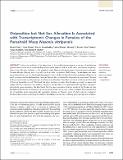Files in this item
Oviposition but not sex allocation is associated with transcriptomic changes in females of the parasitoid wasp Nasonia vitripennis
Item metadata
| dc.contributor.author | Cook, Nicola | |
| dc.contributor.author | Trivedi, Urmi | |
| dc.contributor.author | Pannebakker, Bart A. | |
| dc.contributor.author | Blaxter, Mark | |
| dc.contributor.author | Ritchie, Michael Gordon | |
| dc.contributor.author | Tauber, Eran | |
| dc.contributor.author | Sneddon, Tanya | |
| dc.contributor.author | Shuker, David Michael | |
| dc.date.accessioned | 2015-12-23T11:41:40Z | |
| dc.date.available | 2015-12-23T11:41:40Z | |
| dc.date.issued | 2015-12-01 | |
| dc.identifier | 231547376 | |
| dc.identifier | 8f0470a5-1f3e-40ff-8a8f-ee06a2a4ce35 | |
| dc.identifier | 85016924964 | |
| dc.identifier | 000367257500036 | |
| dc.identifier.citation | Cook , N , Trivedi , U , Pannebakker , B A , Blaxter , M , Ritchie , M G , Tauber , E , Sneddon , T & Shuker , D M 2015 , ' Oviposition but not sex allocation is associated with transcriptomic changes in females of the parasitoid wasp Nasonia vitripennis ' , G3: Genes, Genomes, Genetics , vol. 5 , no. 12 , pp. 2885-2892 . https://doi.org/10.1534/g3.115.021220 | en |
| dc.identifier.issn | 2160-1836 | |
| dc.identifier.other | ORCID: /0000-0001-7913-8675/work/46761113 | |
| dc.identifier.other | ORCID: /0000-0003-4462-0116/work/60427601 | |
| dc.identifier.uri | https://hdl.handle.net/10023/7941 | |
| dc.description | This work was supported by Natural Environment Research Council (NERC) grant (NE/J024481/1). DMS was previously funded by a NERC Advanced Research Fellowship. | en |
| dc.description.abstract | Linking the evolution of the phenotype to the underlying genotype is a key aim of evolutionary genetics and is crucial to our understanding of how natural selection shapes a trait. Here we consider the genetic basis of sex allocation behaviour in the parasitoid wasp Nasonia vitripennis using a transcriptomics approach. Females allocate offspring sex in line with Local Mate Competition (LMC) theory. Female-biased sex ratios are produced when one or few females lay eggs on a patch. As the number of females contributing offspring to a patch increases, less female-biased sex ratios are favoured. We contrasted the transcriptomic responses of females as they oviposit under conditions known to influence sex allocation: foundress number (a social cue) and the state of the host (parasitised or not). We found, that when females encounter other females on a patch, or assess host quality with their ovipositors, the resulting changes in sex allocation is not associated with significant changes in whole-body gene expression. We also found that the gene expression changes produced by females, as they facultatively allocate sex in response to a host cue and a social cue, are very closely correlated. We expanded the list of candidate genes associated with oviposition behaviour in Nasonia, some of which may be involved in fundamental processes underlying the ability to facultatively allocate sex, including sperm storage and utilisation. | |
| dc.format.extent | 796417 | |
| dc.language.iso | eng | |
| dc.relation.ispartof | G3: Genes, Genomes, Genetics | en |
| dc.subject | Sex allocation | en |
| dc.subject | Transcriptomics | en |
| dc.subject | Behaviour | en |
| dc.subject | Gene expression | en |
| dc.subject | Local mate competition | en |
| dc.subject | QH301 Biology | en |
| dc.subject.lcc | QH301 | en |
| dc.title | Oviposition but not sex allocation is associated with transcriptomic changes in females of the parasitoid wasp Nasonia vitripennis | en |
| dc.type | Journal article | en |
| dc.contributor.sponsor | NERC | en |
| dc.contributor.institution | University of St Andrews. School of Biology | en |
| dc.contributor.institution | University of St Andrews. Centre for Biological Diversity | en |
| dc.contributor.institution | University of St Andrews. Institute of Behavioural and Neural Sciences | en |
| dc.contributor.institution | University of St Andrews. Scottish Oceans Institute | en |
| dc.identifier.doi | 10.1534/g3.115.021220 | |
| dc.description.status | Peer reviewed | en |
| dc.identifier.grantnumber | NE/J024481/1 | en |
This item appears in the following Collection(s)
Items in the St Andrews Research Repository are protected by copyright, with all rights reserved, unless otherwise indicated.

